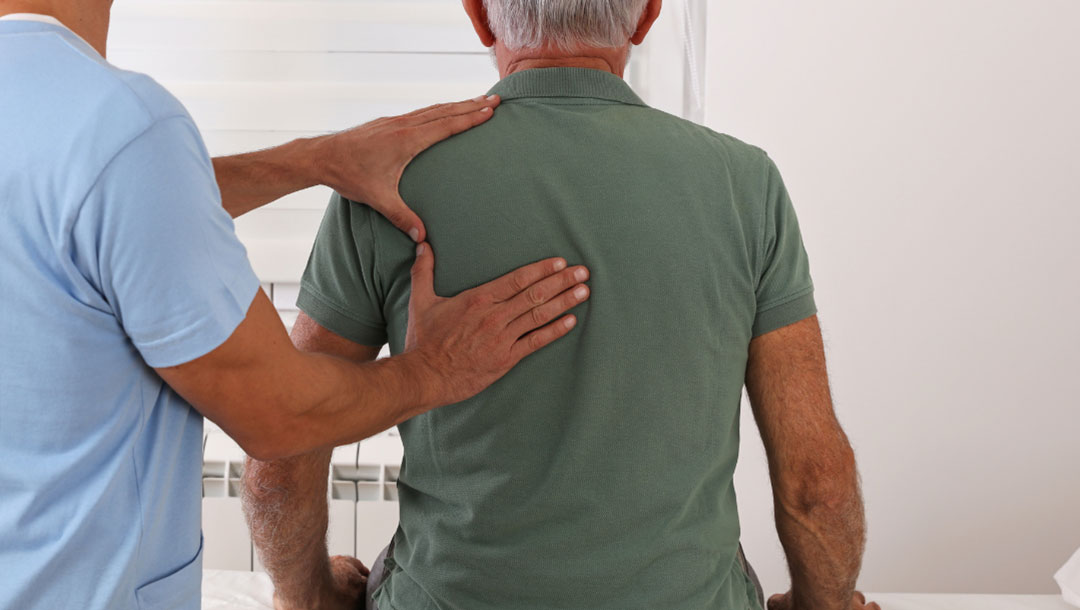What is sciatica?
Sciatica is a type of nerve pain that starts in your lower back or buttock and travels down one or both legs. It happens when the sciatic nerve, the longest nerve in your body, gets pinched or irritated. People with sciatica often feel a sharp, burning or shooting pain that can make walking, sitting or standing uncomfortable.
Though the pain may sound severe, sciatica is very common. Most people get better within a few weeks or months with simple treatments and self-care. However, understanding what causes it and how to manage it can help you get back to your daily routine more quickly.

How sciatica develops
Sciatica isn’t a condition on its own, it’s a symptom that usually starts with a problem in your lower back. When something puts pressure on the sciatic nerve, like a slipped disc, narrowing of the spine, or age-related wear and tear, this can lead to pain, tingling, or weakness that travels down your leg.
Whatever the underlying cause, the result is the same: the sciatic nerve becomes irritated, leading to discomfort along its path.
Who is affected?
Sciatica can develop in almost anyone but some groups are at higher risk:
- Adults aged 30–50: Disc changes start in mid-life and can trigger sciatica.
- People with physically demanding jobs: Manual lifting or heavy work can strain your back.
- Sedentary workers: Sitting for long periods, especially with poor posture, increases pressure on your lower spine.
- Overweight individuals: Extra weight adds stress to spinal structures.
- Smokers: Smoking slows healing and can worsen disc degeneration.
- People with diabetes: High blood sugar can damage nerves, making them more sensitive to pressure.
- Sedentary workers: Sitting for long periods, especially with poor posture, increases pressure on your lower spine.
- Overweight individuals: Extra weight adds stress to spinal structures.
- Smokers: Smoking slows healing and can worsen disc degeneration.
- People with diabetes: High blood sugar can damage nerves, making them more sensitive to pressure.
Signs and symptoms of sciatica
Common signs and symptoms
Some of the more common signs and symptoms of sciatica are:
- Pain down the leg: Often described as sharp, searing, electric-shock or burning, usually on one side.
- Pins and needles or numbness: May feel in the leg or foot, often following the path of the nerve.
- Muscle weakness: Trouble lifting your foot or bending your knee on the affected side.
- Worse pain when sitting: Sitting puts extra pressure on the nerve roots.
- Improved comfort when walking or lying: Movement and certain positions can ease nerve pressure.
When symptoms may worsen
Sciatica pain often flares up:
- After long periods of sitting or standing
- When coughing, sneezing or laughing (it increases pressure on the nerve)
- During certain activities like bending or lifting
- At night, making sleep difficult

Causes and risk factors
Common causes
Sciatica usually stems from changes or pressures on the spine that irritate the nerve, most often due to one of the following:
- Herniated (slipped) disc: A soft spinal disc bulges or ruptures and presses on a nearby nerve root.
- Spinal stenosis: Narrowing of the spinal canal or nerve exits constricts nerve roots, commonly from age-related changes like bone spurs.
- Degenerative disc disease: Wear and tear makes discs thinner and less flexible, which can indirectly pinch nerves as the vertebrae shift.
- Spondylolisthesis: One vertebra slips forward over another, creating pressure on the nerve roots.
- Piriformis syndrome and other muscle issues: Tightness or spasm in the buttock muscles can trap the sciatic nerve as it passes through the pelvis.
Risk factors you should know
Several factors raise your chances of developing sciatica:
- Age: Disc changes start around age 30–40.
- Occupation: Jobs requiring twisting of the back, heavy lifting, or long periods of sitting.
- Sedentary lifestyle: Lack of regular exercise weakens back muscles.
- Obesity: Extra weight stresses your spine.
- Diabetes: Increases risk of nerve damage.
- Smoking: Reduces blood flow to discs, slowing healing.
Understanding your personal risk can help you take steps to protect your spine and reduce the chance of painful flare-ups.
How sciatica is diagnosed
Clinical examination
When you visit your GP or a specialist, the first step is to discuss your back and leg pain. They’ll ask when your symptoms began, how the pain feels, and what activities or positions make it better or worse.
Next, they’ll review your medical history, checking for any past back injuries, surgeries, or health conditions that could play a part. Finally, you’ll move on to a hands-on assessment: gentle tests of your muscle strength, reflexes, and feeling in your legs and feet. One common check is the straight-leg raise, where lifting your leg while lying down often recreates the familiar sciatica twinge and helps confirm which nerve is affected.
Diagnostic tests
If your symptoms are severe, last more than six weeks, or you have red flags (see When to seek medical advice), your doctor may order imaging tests:
- MRI scan: Gives detailed images of soft tissues, showing herniated discs or nerve compression.
- CT scan: Used if MRI is not possible; provides cross-sectional images of bones and nerves.
- X-rays: Rule out fractures, tumours or spinal alignment problems.
- Electromyography (EMG): Measures electrical impulses in nerves and muscles to pinpoint nerve damage.
Treatment options for sciatica
Lifestyle changes and self-care
Many people improve their sciatica with simple measures at home:
- Stay active: Gentle exercise like walking or swimming helps keep your spine mobile.
- Posture: Sit in chairs with good back support, keep feet flat on the floor, and avoid slouching.
- Heat and cold packs: Alternating heat (to relax muscles) and ice (to reduce inflammation) can ease pain.
- Over-the-counter pain relief: Paracetamol or ibuprofen (if suitable for you) may help in the short term.
Doing these self-care steps can reduce pain, speed up recovery, and help you stay mobile while your nerve heals.
Physiotherapy
A physiotherapist will guide you through a personalised plan that often includes:
- Tailored exercises: You’ll learn specific stretches (like gentle hamstring and piriformis stretches) and strengthening moves (such as pelvic tilts and core activation) designed to support your lower back, improve posture, and ease pressure on the sciatic nerve.
- Manual therapy: Hands-on techniques, such as soft tissue massage, joint mobilisations, or gentle spinal manipulations, help to release tight muscles, improve spinal alignment, and boost blood flow for faster healing.
- Posture and lifting advice: You’ll get practical tips for everyday activities, from setting up an ergonomic workstation and choosing supportive seating, to bending and lifting safely (using your legs not your back), so you avoid movements that might trigger a flare-up.
Working with a physiotherapist not only relieves current pain but also builds lasting strength and flexibility, reducing the likelihood of future sciatica episodes.

Medications
If simple self-care and physiotherapy don’t ease your sciatica, your GP may prescribe one or more of the following medicines, chosen to target different aspects of your pain:
- Stronger painkillers: Such as codeine-based medicines for short periods.
- Anti-inflammatories: Prescription NSAIDs to reduce nerve inflammation.
- Muscle relaxants: For severe spasms.
- Neuropathic pain drugs: Such as gabapentin or amitriptyline to calm irritated nerves.
By using the right combination of these medications under your doctor’s guidance, you can achieve quicker relief from intense sciatica pain, making it easier to keep moving and stick with your rehabilitation plan.
Surgery (if applicable)
Surgery is rarely needed but may be considered if you have:
- Progressive muscle weakness in your leg or foot
- Loss of bladder or bowel control (cauda equina syndrome – an emergency)
- Severe pain that doesn’t respond to other treatments after 6–12 weeks
Common operations include:
- Microdiscectomy: Removal of part of a herniated disc to relieve nerve pressure.
- Laminectomy: Removing a small section of bone (lamina) to widen the spinal canal in cases of stenosis.
When non-surgical treatments aren’t enough, surgery can provide lasting relief by directly relieving nerve compression.
Can sciatica be prevented?
While you can’t guarantee sciatica won’t ever develop, especially if you’re predisposed to spinal changes, most people can significantly lower their risk. By keeping your core muscles strong, practising good posture and using safe lifting techniques, you’ll go a long way toward preventing the nerve irritation that triggers sciatica.
Reducing your risks
While not all sciatica can be prevented, these habits lower your chances:
- Regular exercise: Focus on core-strengthening and low-impact activities (e.g. walking, cycling).
- Maintain a healthy weight: Cuts stress on your spine.
- Lift safely: Bend your knees and keep objects close when lifting.
- Sit smart: Use chairs with good lumbar support and take breaks to stretch if you sit for long periods.
- Quit smoking: Improves blood flow and healing.
When to seek medical advice
Signs you shouldn't ignore
Contact your GP or emergency services if you experience:
- Sudden loss of bowel or bladder control
- Severe or worsening muscle weakness in your leg
- Unrelenting pain that doesn’t ease with rest or pain relief
- Numbness in your groin area (“saddle anaesthesia”)
- High fever or unexplained weight loss alongside back pain (could signal infection or other serious condition)
Early assessment ensures that any serious causes are ruled out and that you get the right treatment quickly
Doctors who treat this condition
Related
Spinal stenosis
Muscle cramps
Leg pain

References
- https://www.nhs.uk/conditions/sciatica/ [accessed 01.08.2025]
- https://cks.nice.org.uk/topics/low-back-pain-and-sciatica/ [accessed 01.08.2025]
- https://www.nice.org.uk/guidance/ng59 [accessed 01.08.2025]
- https://www.nimh.nih.gov/health/topics/sciatica [accessed 01.08.2025]
- https://www.ncbi.nlm.nih.gov/books/NBK532232/ [accessed 01.08.2025]

